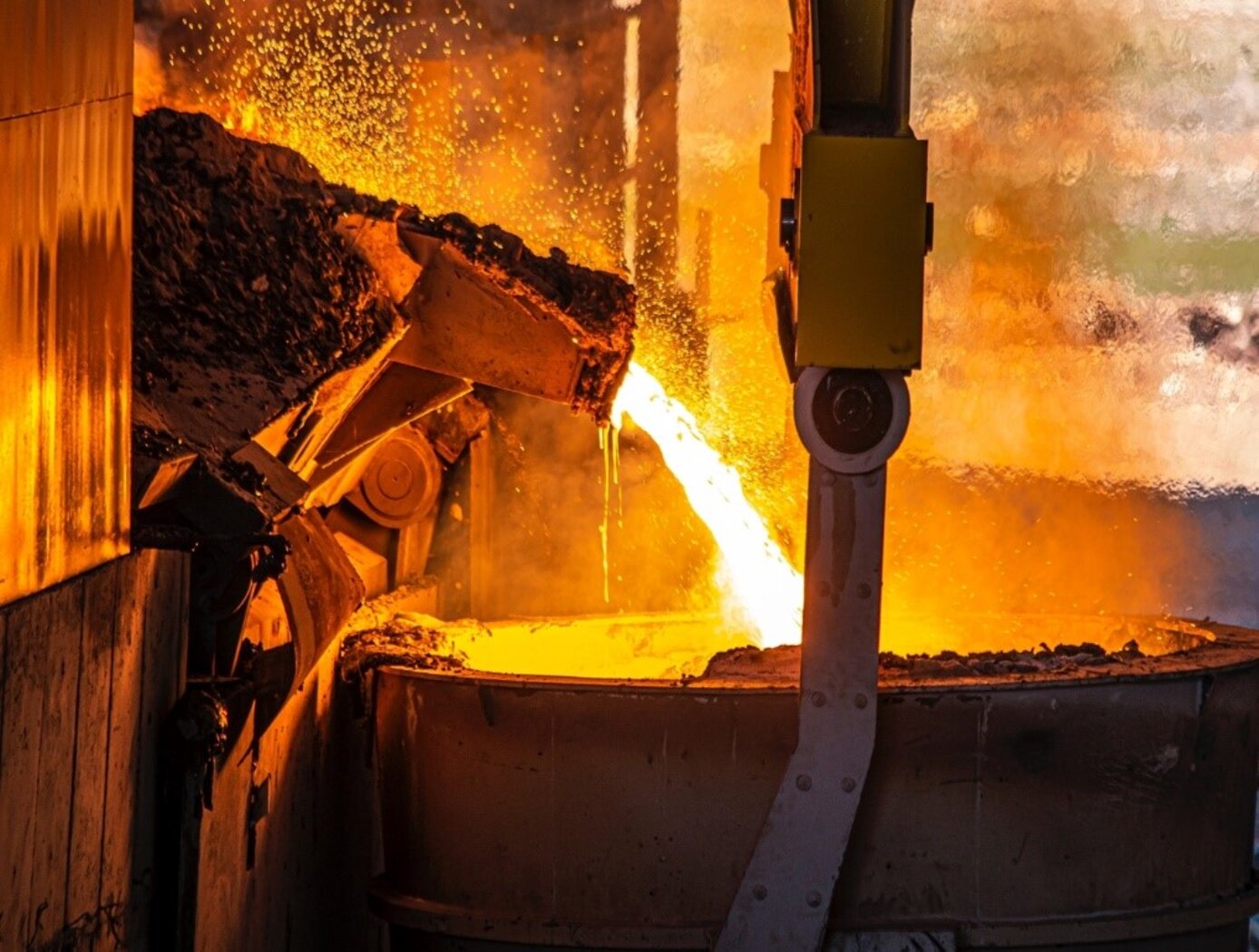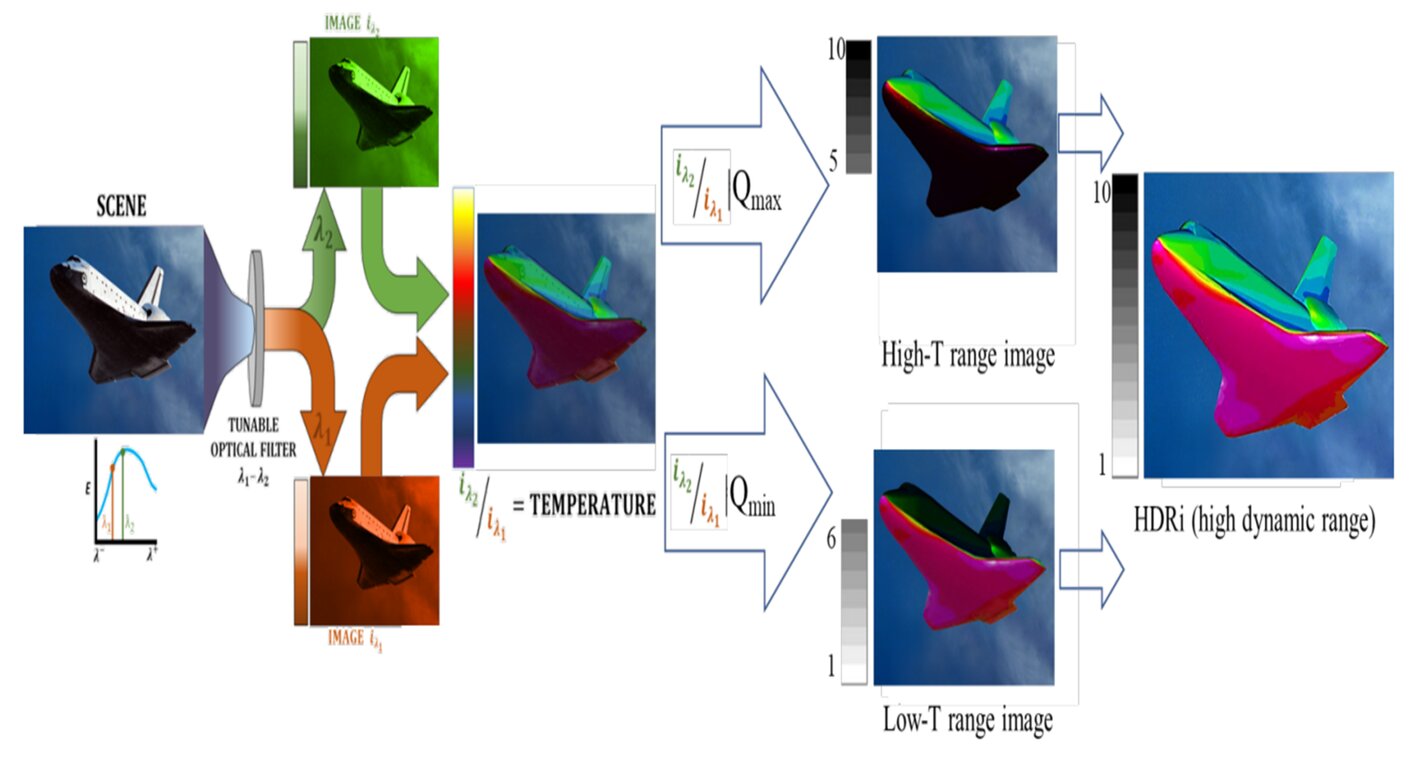Multi-Spectral Imaging Pyrometer
Sensors
Multi-Spectral Imaging Pyrometer (LAR-TOPS-362)
Solid-state broadband infrared imaging system with high dynamic range
Overview
Innovators at NASA Langley Research Center have developed a multi-spectral imaging pyrometer utilizing tunable optics. The system uses a conventional infrared imaging camera as the basis and then incorporates an ultrafast, all solid-state, tunable optical filter combined with unique data processing algorithms to function as a multi-color ratio pyrometer but with true imaging capabilities.
Currently, there is no way to provide automatic, independent, emissivity-based temperature corrections at the pixel level for infrared cameras that operate with broadband detectors. Multiwavelength pyrometric systems can make emissivity-corrected temperature measurements but are not imaging devices and lack the ability to view surface gradients and other subtle variations. Optical systems that measure at several discrete wavelengths require the use of multiple optical filters and are slow, bulky and require high power.
The Technology
This NASA technology transforms a conventional infrared (IR) imaging system into a multi-wavelength imaging pyrometer using a tunable optical filter. The actively tunable optical filter is based on an exotic phase-change material (PCM) which exhibits a large reversible refractive index shift through an applied energetic stimulus. This change is non-volatile, and no additional energy is required to maintain its state once set. The filter is placed between the scene and the imaging sensor and switched between user selected center-wavelengths to create a series of single-wavelength, monochromatic, two-dimensional images. At the pixel level, the intensity values of these monochromatic images represent the wavelength-dependent, blackbody energy emitted by the object due to its temperature. Ratioing the measured spectral irradiance for each wavelength yields emissivity-independent temperature data at each pixel. The filter’s Center Wavelength (CWL) and Full Width Half Maximum (FWHM), which are related to the quality factor (Q) of the filter, are actively tunable on the order of nanoseconds-microseconds (GHz-MHz). This behavior is electronically controlled and can be operated time-sequentially (on a nanosecond time scale) in the control electronics, a capability not possible with conventional optical filtering technologies.


Benefits
- Improved reliability: Solid-state design with no moving parts and small form factor
- Expanded dynamic range: Controlling the Q factor prevents saturation and underfill of detector pixels, enabling detection of temperature over a wider range.
- Enables improved accuracy of temperature measurements: The ability to accurately calculate emissivity as well as gradients over a 2D scene improves the quality of critical temperature information while simplifying data acquisition.
- Broadband capability: The system operates within the wavelength range of 2-10 µm enabling measurement of temperature for a wide range of materials with varying emissive character; the tunable filter may also have applications in detection of multiple known chemical threats that have absorption peaks in this range of wavelength.
Applications
- Aerospace: Imaging and analysis of rocket plumes, combusting flows, and heat shields
- Metals Manufacturing: Process monitoring the melting of metallic ores in mixed states or the formation of surface slag
- Welding: Accurate imaging of weld pool temperatures
- Kiln Processing: Process monitoring in cement kilns
Technology Details
Sensors
LAR-TOPS-362
LAR-20119-1
Reversible optical tuning of GeSbTe phase-change metasurface spectral filters for mid-wave infrared imaging, Julian, Matthew N.; William, Calum; Borg, Stephen; Bartram, Scott; and Kim, Hyun Jung. Optica, Vol. 7, No. 7, July 2020, https://opg.optica.org/optica/fulltext.cfm?uri=optica-7-7-746&id=433160
Tunable mid-wave infrared Fabry-Perot bandpass filters using phase-change GeSbTe, Williams, Calum; Hong, Nina; Julian, Matthew; Borg, Stephen; and Kim, Hyun Jung, Optics Express, Vol. 28, No.7, March 2020, https://opg.optica.org/oe/fulltext.cfm?uri=oe-28-7-10583&id=429492
Electrically reconfigurable phase-change transmissive metasurface. Cosmin Constantin Popescu, Kiumars Aryana, Parth Garud, Khoi Phuong Dao, Steven Vitale, Vladimir Liberman, Hyung-Bin Bae, Tae-Woo Lee, Myungkoo Kang, Kathleen A. Richardson, Matthew Julian, Carlos A. Rıos Ocampo, Yifei Zhang, Tian Gu, Juejun Hu and Hyun Jung Kim, Advanced Materials, May 2024, https://doi.org/10.1002/adma.202400627
Tunable mid-wave infrared Fabry-Perot bandpass filters using phase-change GeSbTe, Williams, Calum; Hong, Nina; Julian, Matthew; Borg, Stephen; and Kim, Hyun Jung, Optics Express, Vol. 28, No.7, March 2020, https://opg.optica.org/oe/fulltext.cfm?uri=oe-28-7-10583&id=429492
Electrically reconfigurable phase-change transmissive metasurface. Cosmin Constantin Popescu, Kiumars Aryana, Parth Garud, Khoi Phuong Dao, Steven Vitale, Vladimir Liberman, Hyung-Bin Bae, Tae-Woo Lee, Myungkoo Kang, Kathleen A. Richardson, Matthew Julian, Carlos A. Rıos Ocampo, Yifei Zhang, Tian Gu, Juejun Hu and Hyun Jung Kim, Advanced Materials, May 2024, https://doi.org/10.1002/adma.202400627
|
Tags:
|
Similar Results

Fast and widely tunable monolithic optical parametric oscillator for laser spectrometer
NASA Goddard Space Flight Center has developed a faster and widely-tunable monolithic optical parametric oscillator for use in laser spectrometers. This technology provides a continuously-tunable spectrum across any target, adding flexibility to the overall instrument. In addition, only 1 nonlinear crystal and oscillator pump source are used, greatly simplifying the spectrometer system.
Ruggedized Infrared Camera
This new technology applies NASA engineering to a FLIR Systems Boson® Model No. 640 to enable a robust IR camera for use in space and other extreme applications. Enhancements to the standard Boson® platform include a ruggedized housing, connector, and interface. The Boson® is a COTS small, uncooled, IR camera based on microbolometer technology and operates in the long-wave infrared (LWIR) portion of the IR spectrum. It is available with several lens configurations. NASA's modifications allow the IR camera to survive launch conditions and improve heat removal for space-based (vacuum) operation. The design includes a custom housing to secure the camera core along with a lens clamp to maintain a tight lens-core connection during high vibration launch conditions. The housing also provides additional conductive cooling for the camera components allowing operation in a vacuum environment. A custom printed circuit board (PCB) in the housing allows for a USB connection using a military standard (MIL-STD) miniaturized locking connector instead of the standard USB type C connector. The system maintains the USB standard protocol for easy compatibility and "plug-and-play" operation.

Enhanced Fabrication Improves Temperature Sensing in Cryogenic Humid Environments
This technology was developed to improve Armstrong's multi-patented FOSS system, which has long been used to measure temperature and liquid levels in cryogenic environments. When the sensing system's fibers trapped humidity from the surrounding environment before their submersion into cryogenic liquids, the moisture adversely affected outputs. A new manufacturing process solves this problem, increasing reliability and accuracy not only of NASA's FOSS but also any fiber optic sensing system.
How It Works
Armstrong has developed a two-step process to assemble the sensors. First, the bare sensor fiber is inserted into an oven to expel all moisture from the fiber coating. Then, the moisture-free fiber is placed inside a humidity-controlled glove box to prevent it from absorbing any new moisture. While inside the glove box, the fiber is inserted into a loose barrier tubing that isolates the fiber yet is still thin enough to provide adequate thermal transfer. The tubing can be further purged with various gases while it is inside the glove box to provide additional moisture isolation.
This innovation is particularly useful for fiber optic systems that measure temperature and that identify any temperature stratifications within cryogenic liquids.
Why It Is Better
This process seals sensor fibers from environmental moisture, enabling fiber optic sensing systems to operate reliably in humid environments. The innovation eliminates erroneous readings that can occur due to moisture collection on the fiber sensors.
For more information about the full portfolio of FOSS technologies, see DRC-TOPS-37 or visit https://technology-afrc.ndc.nasa.gov/featurestory/fiber-optic-sensing

Luminescence-Based Temperature Mapping and Sensing Systems
In order to obtain real-time temperature measurements with this technology, the phosphor can either be applied as a coating onto the surface of the object for temperature mapping, or incorporated onto a sensor and attached to the end of a fiber-optic probe for local temperature measurements. Next, the object is exposed to a pulsed light source, which causes the temperature-sensing phosphor to produce an ultra-bright broadband emission. An algorithm is used to evaluate post-pulse emission decay time, which is then converted to a precise temperature reading.
State-of-the-art temperature sensing phosphors suffer from thermal quenching, or unacceptable loss of signal intensity as temperature increases. Alternative high-temperature measurement systems such as thermocouples and pyrometers, offer only spot measurements. Moreover, thermocouples suffer from attachment issues and electromagnetic interference, while pyrometers frequently suffer from reflected radiation interference and unknown surface emissivity. Cr:GdAlO3, which retains ultra-bright emission intensity to temperatures well above 1000°C, provides an ideal solution to all of these issues with a few added benefits. It has a perovskite structure that is both non-reactive and stable in high-temperature environments. Furthermore, it possesses a favorable electron energy level spacing that enables this sensor to maintain stronger signal intensity than its competitors. Due to the broad absorption and emission bands for Cr:GdAlO3 there is considerable flexibility in the choice of excitation and emission wavelength detection bands. The combination of these factors makes this technology a clear choice for luminescence-based optical high-temperature sensing for a variety of industries from aerospace to manufacturing.

CubeSat Compatible High Resolution Thermal Infrared Imager
This dual band infrared imaging system is capable of spatial resolution of 60 m from orbit and earth observing expected NEDT less than 0.2o C. It is designed to fit within the top two-thirds of a 3U CubeSat envelope, installed on the International Space Station, or deployed on other orbiting or airborne platforms. This infrared imaging system will utilize a newly conceived strained-layer superlattice GaSb/InAs broadband detector array cooled to 60 K by a miniature mechanical cryocooler. The camera is controlled by a sensor chip assembly consisting of a newly developed 25 m pitch, 640 x 512 pixel.



